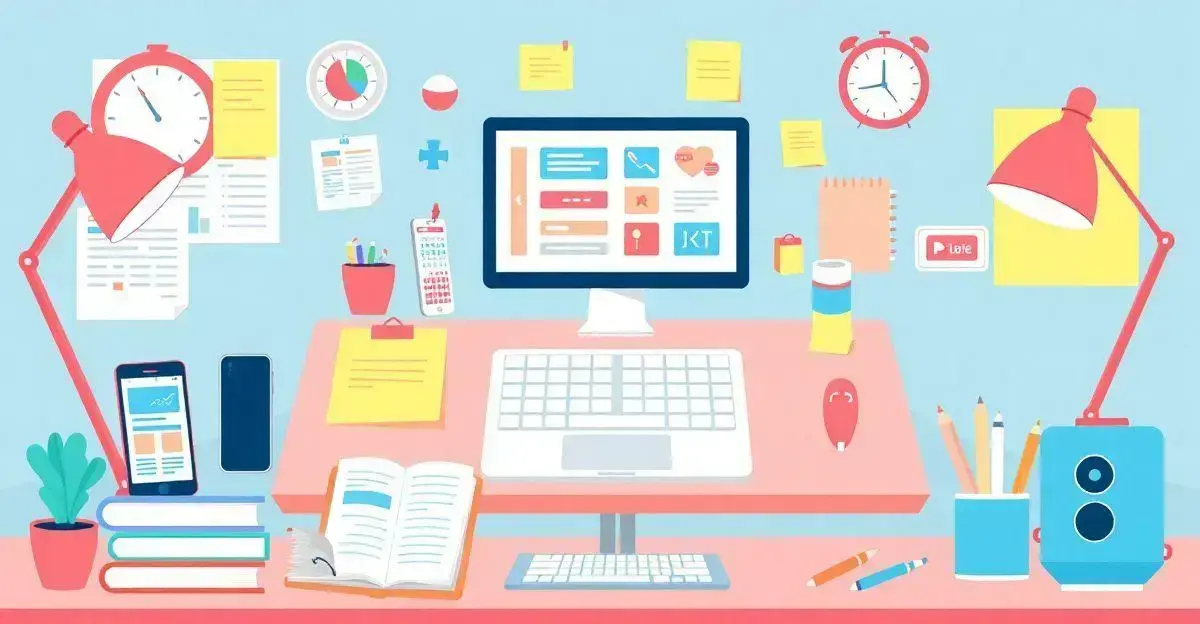Work productivity tips are crucial for anyone looking to get more done in less time. Whether you’re a busy professional or a student, improving productivity helps you stay on track and reduce stress. Small changes in your approach can lead to big results.
From time management strategies to practical tools, there are simple ways to work smarter, not harder. Understanding how to prioritize tasks and create a focused environment can make a world of difference in your efficiency.
Want to learn how to boost your productivity? Keep reading for easy tips that can help you achieve more and feel less overwhelmed.
Understanding Work Productivity
Understanding work productivity tips is essential for anyone aiming to maximize their efficiency and achieve their goals. Productivity refers to how effectively you can use your time and resources to produce results.
In simple terms, it’s about working smarter, not harder. To improve your work productivity, start by identifying your key tasks. What needs to be done, and how can you prioritize these tasks effectively? This involves setting clear, measurable goals that guide your daily activities.
Moreover, understanding your peak productivity hours can significantly enhance your performance. Everyone has times during the day when they feel most energetic and focused. By scheduling the most challenging tasks during these periods, you can leverage this natural rhythm to improve outcomes.
Another critical aspect is minimizing distractions. In a world filled with constant notifications and social media, it’s vital to create an environment that encourages focus. This may involve turning off notifications, setting boundaries, and even organizing your workspace to remain clutter-free.
Understanding work productivity involves recognizing key tasks, leveraging your natural energy cycles, and creating an environment conducive to focus.
Benefits of Improved Productivity

Improved productivity brings significant benefits to both individuals and organizations. One of the key advantages is enhanced efficiency, allowing you to accomplish more tasks in less time. When you focus on what truly matters, you can allocate your energy toward high-impact activities.
This leads to increased job satisfaction as you see progress in your work, which can motivate you further. Furthermore, better productivity means that deadlines can be met more comfortably, reducing stress levels in the workplace.
Another benefit is the potential for greater innovation. When you manage your time and resources effectively, you create opportunities for creative thinking and problem-solving. This can lead to discovering new ways to enhance processes or develop products that genuinely meet customer needs.
Additionally, improved productivity often results in enhanced profitability for businesses. By streamlining operations and increasing output, companies can see a direct impact on their bottom line. This allows for reinvestment in areas that further promote growth.
Thus, embracing work productivity tips is not just about working harder, but about working smarter and achieving sustainable success.
Setting Realistic Goals
Setting realistic goals is a crucial step for improving your productivity. It involves establishing achievable targets that are aligned with your skills and resources. When you set goals that are too high, you risk becoming discouraged and losing motivation.
Instead, focus on small, incremental objectives that lead to larger achievements. SMART goals, which stand for Specific, Measurable, Achievable, Relevant, and Time-bound, an offer a solid framework for creating your goals. This method ensures that you have clear expectations and timelines, helping you stay on track.
Additionally, regularly reviewing your goals can help you adapt to any challenges that arise. If you find certain goals are overly ambitious, adjust them to better fit your current circumstances. This flexibility can prevent burnout and keep you motivated.
Celebrating small victories along the way can also boost your confidence and reinforce your commitment to your larger objectives. Incorporating work productivity tips into this process can further enhance your goal-setting strategy, ensuring sustained progress and achievement.
Time Management Techniques

- Use the Pomodoro Technique: Break work into 25-minute chunks followed by 5-minute breaks.
- Create to-do lists: Prioritize tasks based on urgency and importance.
- Set deadlines: Create a sense of urgency and reduce procrastination.
- Utilize calendar tools: For better organization and visualization of commitments.
- Learn to say no: To tasks that don’t align with your goals to prevent overload.
- Implement time blocking: Dedicate specific times for different activities.
The Role of Breaks in Productivity
The role of breaks in productivity is often underestimated. Taking regular breaks helps to recharge your mind and can lead to increased focus and creativity. When you work for long periods without pausing, your brain can become fatigued, decreasing your performance.
Implementing short breaks every hour can significantly boost your overall output and is one of the work productivity tips that can transform your workflow.
During these breaks, it’s beneficial to step away from your workspace. Stretching or taking a quick walk can help refresh your body and mind. Engaging in light physical activity gets your blood flowing and can improve your mood. Moreover, changing your environment, even for a few minutes, allows you to return to your tasks with a new perspective.
Studies show that individuals who take regular breaks experience less stress and are less likely to suffer from burnout. Therefore, it is essential to incorporate breaks into your daily routine to maintain high levels of productivity.
Tools to Boost Your Efficiency

There are several tools that can help boost your efficiency during work. First, consider using a task management application like Todoist or Asana. These tools allow you to create and organize tasks and set deadlines, which helps you stay focused and productive, and are key work productivity tips to stay on track.
Another great tool is a time-tracking software, such as Toggl, which enables you to monitor how your time is spent. By analyzing your activities, you can identify patterns and make adjustments to improve your workflow.
You might also find it beneficial to use note-taking tools, like Evernote or Microsoft OneNote, to keep all your ideas and important information in one place. This keeps you organized and ensures that you can quickly access essential notes when needed.
Additionally, consider using automation tools such as Zapier to link different applications together. This can save you time by automating repetitive tasks. Furthermore, if you often conduct video calls, using software like Zoom can streamline meetings and improve communication with your team.
Adopting these tools can significantly enhance your productivity and efficiency at work.
Creating a Productive Workspace
Creating a productive workspace is essential for maximizing focus and efficiency. Start by ensuring that your workstation is organized. A clean and tidy desk can eliminate distractions and help you concentrate better.
Consider using organizers or trays to keep essential items within reach without cluttering your workspace—an important work productivity tip for a smooth workflow.
Lighting is another vital factor. Natural light is ideal, as it can improve mood and reduce eye strain. If natural light is limited, using bright, white light can mimic daylight and maintain alertness. Additionally, adjust your chair and desk height to ensure you maintain good posture, which is crucial for comfort and focus throughout the day.
Adding personal touch can also enhance your workspace. Including items like plants or pictures can create a welcoming environment. Plants can improve air quality and increase feelings of well-being, making you more productive. Furthermore, minimize noise distractions by using noise-canceling headphones or soft background music if it helps you concentrate.
Finally, consider incorporating tools like a timer or a task board to keep you on track. These tools can help manage your time effectively and keep your tasks visible, which can drive you to complete your work efficiently.
Mindfulness and Focus Strategies

Mindfulness and focus strategies are essential for maintaining productivity in today’s busy world. One effective method is to practice deep breathing exercises, which can help calm the mind and enhance concentration—an excellent work productivity tips for staying on task.
Take a moment to stop what you are doing and inhale deeply for four counts, hold for four counts, and exhale for four counts. This simple technique boosts oxygen flow to the brain, allowing you to think more clearly.
Another effective strategy is to set specific time blocks for focused work. This involves dedicating a certain amount of time to a task without interruption. During these blocks, eliminate distractions by turning off notifications on your phone and computer.
You can use tools like the Pomodoro Technique, which suggests working for 25 minutes followed by a 5-minute break. This method helps to maintain high levels of focus while allowing for necessary rest.
Additionally, incorporating mindfulness practices, such as meditation or mindful walking, into your daily routine can improve your ability to concentrate. Just a few minutes of mindfulness can clear your mind of clutter and help you stay present in your work tasks.
Finally, make a habit of reflecting on your day. Spend a few minutes at the end of each day journaling about what you accomplished and any distractions you faced. This practice can help you identify patterns and make adjustments for better focus in the future.
Measuring Your Productivity Progress
Measuring your productivity progress is key to understanding how effectively you are working. One effective method is to regularly review your completed tasks.
Create a daily or weekly checklist to list tasks you’ve accomplished. This provides a visual representation of your efforts and can be motivating to see what you have achieved.
Another strategy is to set specific metrics for your work. For instance, if you’re in sales, keep track of the number of calls made or deals closed each week.
This quantitative data allows you to evaluate your performance over time.
Additionally, consider using productivity tools and apps that track your time spent on tasks. Tools like Toggl or RescueTime can offer insights into where you are spending your time and help identify areas for improvement. Work productivity tips like this can highlight time management challenges and solutions.
Reflecting on your progress regularly is essential. You might find it helpful to set aside time at the end of each week to evaluate what worked well and what didn’t. This self-reflection can lead to actionable plans that enhance your productivity further.
Frequently Asked Questions about Work Productivity Tips
What are work productivity tips?
Work productivity tips are strategies and techniques that help individuals and teams work more efficiently and effectively to achieve their goals.
How can setting realistic goals improve productivity?
Setting realistic goals provides clear direction and helps you maintain focus, making it easier to track progress and stay motivated.
Why are breaks important for productivity?
Taking breaks helps rejuvenate your mind, reduces fatigue, and can lead to improved concentration and creativity when you return to work. Regular breaks are essential for maintaining work productivity over long periods.
What tools can assist in improving work efficiency?
Productivity tools like task management apps, time tracking software, and note-taking applications can help you organize tasks and manage time better.
What is the Pomodoro Technique?
The Pomodoro Technique is a time management method that encourages work in short bursts (usually 25 minutes) followed by brief breaks.
How can mindfulness improve focus in the workplace?
Mindfulness practices, such as meditation and deep breathing, help clear distractions and enhance your ability to concentrate on tasks.
How often should I measure my productivity progress?
Regularly measuring your productivity, such as weekly or monthly, can help you identify areas of success and those that need improvement.